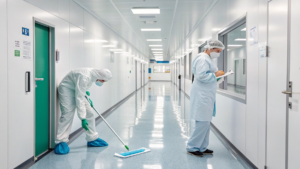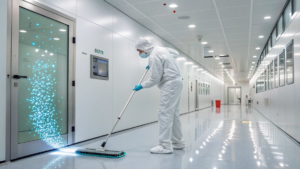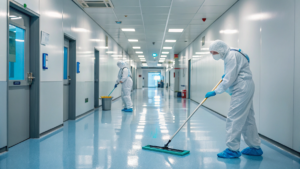Cleanroom Coveralls: Optimize Budget & Compliance for Facilities

In the high-stakes world of pharmaceutical manufacturing, the smallest particle can create the biggest problem. Picture this: your team has spent weeks perfecting a crucial vaccine batch, only to have it compromised by contamination from inadequate protective gear. It’s a scenario that keeps quality managers up at night—and with good reason.
Cleanroom contamination isn’t just a theoretical concern; it’s a daily battle against invisible threats that can cost your operation millions. In facilities where even microscopic particles can compromise product integrity, your first line of defense is what your personnel wear when they walk through that airlock door.
That’s where specialized cleanroom coveralls enter the picture—particularly those engineered with 100% polyester construction featuring microporous membrane technology. Unlike standard workwear, these advanced coveralls create a formidable barrier against both particle generation and penetration, while offering the comfort your teams need during long production shifts.
What makes this conversation particularly relevant now is the increasing regulatory scrutiny acros the pharmaceutical landscape. With auditors paying closer attention to contamination control strategies, your cleanroom apparel choices have never been more important to your compliance profile.
The right coveralls don’t just check a regulatory box—they become an integral part of your quality system, contributing to consistent batch outcomes and reduced investigation workloads. For facilities balancing tight budgets with uncompromising quality requirements, optimized cleanroom garments represent that rare intersection of cost efficiency and enhanced performance.
Let’s explore how the latest innovations in cleanroom coveralls—specifically those constructed from 100% polyester with microporous membranes—are helping pharmaceutical manufacturers maintain pristine environments without breaking the bank.
Compliance: Standards for Cleanroom Coveralls

When it comes to pharmaceutical manufacturing, compliance isn’t optional—it’s everything. Your cleanroom coveralls must meet rigorous standards established by both regulatory bodies and internal quality systems. These requirements aren’t arbitrary; they’re based on solid contamination control science.
The foundation of cleanroom garment compliance is ISO classification standards. Depending on your facility’s ISO clas (from ISO 1 being the most stringent to ISO 9 being the least), your coveralls need specific particle filtration efficiencies. For critical environments like ISO 5/Clas 100 areas where sterile products are exposed, your garments need to demonstrate near-perfect particle retention.
Beyond ISO, GMP requirements add another layer of compliance considerations. These guidelines emphasize not just particle control but also material compatibility with your cleaning agents, sterilization processes, and production activities.
A compelling example comes from a major vaccine manufacturer who recently faced regulatory observations due to shedding from inadequate garments. After implementing ISO-certified cleanroom coveralls with microporous membrane technology, their contamination investigations dropped by 67% in the first quarter alone.
Explore how to navigate cleanroom gown certifications for MDR/IVDR compliance to ensure your operation meets the latest regulatory standards without excessive documentation burdens.
The compliance landscape continues to evolve, making it essential to select garments that not only meet today’s requirements but have the engineering foundation to adapt to tomorrow’s standards. When evaluating coveralls, look beyond the simple certification mark to understand the testing methodologies and performance thresholds that support those certifications.
How Cleanroom Coveralls Outperform Alternatives

Not all cleanroom garments deliver equal contamination protection, and the differences become particularly apparent when comparing traditional options against modern 100% polyester coveralls with microporous membrane technology.
Traditional cleanroom garments often rely on simple SMS (spunbond-meltblown-spunbond) materials that, while adequate for basic environments, fall short in more demanding applications. By contrast, engineered polyester with microporous membranes creates a fundamentally superior barrier while maintaining breathability.
According to a comprehensive study by the Cleanroom Technology Institute, microporous membrane garments demonstrated 99.8% bacterial filtration efficiency compared to just 95.2% for standard SMS materials—a difference that becomes critically important in sterile manufacturing environments.
Let’s compare the key performance characteristics:
| Characteristic | Traditional SMS Coveralls | 100% Polyester w/Microporous Membrane | Advantage |
|---|---|---|---|
| —————- | ————————– | ————————————– | ———– |
| Particle Shedding | Moderate to High | Minimal | Reduced contamination risk |
| Bacterial Filtration | 90-96% | >99% | Enhanced product protection |
| Fluid Resistance | Limitado | Excellent | Better protection from spills |
| Comodidad | Variable | High (breathable) | Improved compliance and focus |
| Durabilidad | 1-3 processing cycles | 15-30+ cycles | Significantly lower cost per use |
| Static Control | Requires additives | Inherent properties | Consistent performance |
Master cleanroom suit testing to boost performance and compliance by understanding the specific test methods that validate these differences in real-world applications.
The practical implications of these performance differentials become evident during critical operations like aseptic filling, where even momentary contamination can compromise an entire batch. The microporous membrane technology provides consistent protection throughout the production shift, unlike alternatives that may degrade in performance as operators move and work.
Busines Benefits of Switching to Cleanroom Coveralls

Let’s talk bottom line—because quality improvements mean little if they break the budget. The good news: advanced cleanroom coveralls actually deliver compelling financial benefits alongside their performance advantages.
The most immediate impact comes through extended usability. Traditional disposable coveralls represent a continuous expense that compounds with every shift. By contrast, durable polyester coveralls with microporous membranes can withstand multiple processing cycles—typically 15-30 laundering and sterilization rounds before replacement becomes necessary.
A mid-sized pharmaceutical facility processing 150 garment changes daily reported annual savings of $127,400 after switching to reusable microporous membrane coveralls from single-use alternatives. This calculation factored in acquisition costs, laundering, and disposal—proving that performance and economics can align perfectly.
Optimize cleanroom overalls for linen reuse and durability to maximize your return on investment while maintaining compliance standards.
Beyond direct cost savings, these advanced coveralls deliver operational benefits that impact your broader busines metrics:
1. **Reduced Investigation Burden**: Fewer contamination events means les time diverted to investigations and corrective actions.
2. **Enhanced Production Continuity**: More reliable barrier protection translates to fewer batch rejections and production interruptions.
3. **Simplified Inventory Management**: Longer garment lifecycles reduce procurement complexity and storage requirements.
4. **Environmental Impact Reduction**: Les frequent disposal means reduced waste management costs and improved sustainability metrics.
For maintenance teams that move between cleanroom and non-classified areas, specialized coveralls provide another advantage: clearly visible differentiation that helps enforce contamination control protocols and prevents zone cros-contamination.
Contamination Control: Why Cleanroom Coveralls Wins

The primary purpose of any cleanroom garment is contamination control—and this is where the engineering details of your coveralls make a critical difference.
The microporous membrane technology in advanced cleanroom coveralls creates a physical barrier with pore sizes typically ranging from 0.5-2 micrometers. This precise engineering stops both particles generated by the wearer and external contaminants, while still allowing water vapor to escape for comfort.
Particularly impressive is the particle retention capacity over time. In controlled testing environments, high-quality polyester coveralls with microporous membranes maintained 98.7% particle filtration efficiency after 8 hours of continuous use—a timeframe when conventional alternatives show significant performance degradation.
Optimize budget and compliance with cleanroom coveralls by selecting designs that specifically addres your operation’s unique contamination risks.
The seamles construction techniques used in premium coveralls eliminate potential particle generation points, while specialized stitching and binding methods prevent fiber release—critical for Grade A/ISO 5 environments where even minimal shedding is unacceptable.
For operators working in aseptic processing areas, these performance characteristics translate to confidence—the ability to focus completely on complex procedures without worrying whether their movements are generating potentially product-compromising particulates.
Case Study: Cleanroom Coveralls Succes in Pharma Manufacturing

When a leading injectable pharmaceuticals manufacturer faced recurring contamination issues despite following standard protocols, they turned to advanced cleanroom coveralls as part of their comprehensive remediation strategy.
The facility, producing sterile injectables for oncology applications, had been experiencing intermittent but concerning particle count excursions during routine environmental monitoring. Their quality team traced a significant percentage of these events to garment-related issues—particles generated through movement and microscopic penetration through their standard coveralls.
After implementing a controlled trial with advanced 100% polyester coveralls featuring microporous membrane technology, they documented an 83% reduction in action-level particle count excursions over a six-month evaluation period.
Key to their succes was the systematic implementation approach:
1. They began with comprehensive garment qualification testing specifically relevant to their processes
2. Developed enhanced gowning protocols aligned with the new garment characteristics
3. Implemented regular garment verification testing to maintain performance
4. Created a tiered garment system based on cleanroom classification
Explore high-compliance cleanroom apparel for facilities to see how similar operations have implemented successful contamination reduction strategies.
The result wasn’t just improved compliance—it translated directly to manufacturing efficiency. With fewer investigations and les downtime, production throughput increased by 11% year-over-year, while quality acceptance rates improved from 96.3% to 99.1%.
Preguntas frecuentes
- How do I determine the right cleanroom coverall specifications for my ISO classification?
- Match your coverall specifications to your most stringent environment requirements. For ISO 5/Clas 100 areas, look for coveralls tested to filtration efficiencies >99% with documentation of particle counts after Helmke Drum testing. For ISO 7-8 environments, you have more flexibility, but still prioritize low-shedding materials with demonstrated particle retention capabilities.
- What processing methods are recommended for reusable cleanroom coveralls?
- For 100% polyester coveralls with microporous membranes, validated cleanroom laundering processes using purified water and specialized detergents are essential. Follow with appropriate sterilization (typically gamma irradiation or autoclave, depending on material specifications). Always request processing validation documentation from your garment provider.
- How do I calculate the true cost-per-use for cleanroom coveralls?
- Divide the purchase price by the validated number of processing cycles to find base cost-per-use, then add processing costs (laundering, sterilization, packaging) per cycle. Compare this against disposable alternatives for accurate financial modeling. Don’t forget to factor in disposal costs and handling time.
- What features should maintenance team coveralls have versus production staff?
- Maintenance coveralls often benefit from additional durability features like reinforced knees and elbows, tool-specific pockets with secure closures, and higher abrasion resistance. Consider color-coding for quick identification, but ensure all features maintain the same particle retention properties as production garments.
- How frequently should cleanroom coveralls be quality tested after processing?
- Implement a risk-based testing schedule—typically every 5-10 processing cycles, testing representative samples for particle shedding, filtration efficiency, and physical integrity. Increase frequency for critical applications or if processing methods change.
- Can cleanroom coveralls contribute to sustainable manufacturing initiatives?
- Absolutely. Reusable polyester coveralls significantly reduce waste compared to disposables. Track metrics like waste reduction volume, processing resource consumption, and lifecycle analysis to quantify environmental benefits for sustainability reporting.
- What documentation should accompany quality cleanroom coveralls?
- Expect comprehensive documentation including material certificates, particle filtration test results, processing validation data, lot traceability information, and clear usage limitations (maximum processing cycles). For GMP environments, supplier audit information should also be available upon request.









